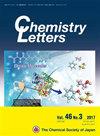Pd-Pt-P 无定形纳米颗粒的合成
IF 1.1
4区 化学
Q3 CHEMISTRY, MULTIDISCIPLINARY
引用次数: 0
摘要
无定形材料具有独特的性能,包括高耐腐蚀性和催化活性,因此是非常有吸引力的材料。在纳米尺度上制造这种材料能有效地最大限度地提高其性能。然而,用块状非晶材料常用的传统快速冷却方法很难合成非晶纳米材料。因此,有关非晶纳米材料的报道不如块体材料多。在此,我们首次报道了采用两步合成法合成 Pd-Pt-P 无定形纳米粒子。我们还对它们进行了表征。本文章由计算机程序翻译,如有差异,请以英文原文为准。
Synthesis of Pd–Pt–P amorphous nanoparticles
Amorphous materials are very attractive materials because of their unique properties, including high corrosion resistance and catalytic activity. Creating such materials on a nanoscale is very effective in maximizing their performance. However, it is difficult to synthesize amorphous nanomaterials by conventional rapid cooling methods, commonly used for bulk amorphous materials. Therefore, there are not as many reports about amorphous nanomaterials as bulk materials. Herein we report the first synthesis of Pd–Pt–P amorphous nanoparticles by a two-step synthesis method. They were also characterized.
求助全文
通过发布文献求助,成功后即可免费获取论文全文。
去求助
来源期刊

Chemistry Letters
化学-化学综合
CiteScore
3.00
自引率
6.20%
发文量
260
审稿时长
1.2 months
期刊介绍:
Chemistry Letters covers the following topics:
-Organic Chemistry-
Physical Chemistry-
Inorganic Chemistry-
Analytical Chemistry-
Materials Chemistry-
Polymer Chemistry-
Supramolecular Chemistry-
Organometallic Chemistry-
Coordination Chemistry-
Biomolecular Chemistry-
Natural Products and Medicinal Chemistry-
Electrochemistry
 求助内容:
求助内容: 应助结果提醒方式:
应助结果提醒方式:


